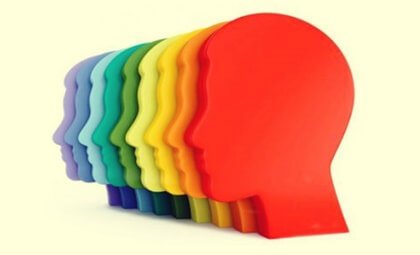The four major Jungian archetypes of the self are also known as ‘higher’ or ‘main’ archetypes. In fact, they’re unconscious representations that have a great influence on the development of the human psyche. This is according to the analytical psychology of Carl Jung.
Archetypes are universal patterns that form part of the collective unconscious. In other words, they’re unconscious traits common to all humanity. In fact, they determine specific ways of being.
Carl Jung used religion and mythology to define these patterns and models. Hence, he arrived at the definition of a large number of archetypes. However, there are four that are of special importance. These are known as archetypes of the self. They’re as follows:
“Your vision will become clear only when you can look into your own heart. Who looks outside, dreams; who looks inside, awakes.”
-Carl Gustav Jung-
Anima and Animus
Anima
The anima is one of the four major Jungian archetypes of the self. In fact, the concept comes from the Latin for the soul. It corresponds to the image of the eternal feminine in the unconscious of a man. It’s linked to the eros principle. It defines or reflects the nature of the relationships that a man establishes with a woman.
For Jung, this archetype has four phases of development or four levels of evolution:
- Eva. It corresponds to woman as the object of man’s desire. In this way, the woman provides nourishment, security, and love. The basic archetype would be Eve or Gaia.
- Helen. Woman’s basic instinct acquires new nuances. In fact, they’re seen as being self-reliant, intelligent, and insightful, if not always virtuous. The essential archetype would be Helen of Troy.
- Mary. Spiritualization or spiritualized motherhood. Men perceive women as virtuous. It corresponds to the model of the Virgin Mary.
- Sophia. The wisdom or wisdom of the eternal feminine. Women have completely integrated and possess both negative and positive qualities. It corresponds to Sofia, the Greek goddess of wisdom.
Animus
The animus is the counterpart of the anima. It corresponds to the image of the eternal masculine in the unconscious of a woman. Ánimus refers to the concept of ‘spirit’. It’s governed by the principle of logos. Furthermore, it’s linked to the world of ideas and the spiritual. Both in this case, as in the previous one, the unconscious identification with the respective archetype causes a feeling of disillusionment with the opposite sex.
As with the anima, according to Jung, the animus has four levels of evolution:
- Tarzan. The representation of physical power, the athlete. The paradigm would be Hercules.
- Byron. Initiative and drive. It’s represented in the mythological figure of Apollo.
- Lloyd George. The virtues are transformed into words. Hence, the priest or the teacher appears.
- Hermes. The highest manifestation of the masculine. It’s the one that reconciles the conscious and the unconscious. It’s represented by the figure of Hermes.
Persona
The persona represents the unconscious area of oneself that one wants to share with others. In fact, it could be said to be something approaching one’s ‘public image’. It’s made up of unconscious elements. However, these harmonize with conscious elements. For this reason, they want to make themselves known to others.
The persona coincides with the Latin word, which, in its original meaning, means ‘mask’. Therefore, the persona as an archetype has to do with the social self. It also concerns the many facets that it adopts according to the specific circumstances. It’s governed by the principle of adaptation.
Shadow
The shadow would be the opposite of the person. In fact, Jung defined it with these words: ‘the shadow is the image of ourself that slides along behind us as we walk towards the light’. It’s one of the most interesting archetypes of the self. In fact, it corresponds to the hidden part of an individual. In effect, it’s their ‘other face’, the one hidden not only from the eyes of others but also from themselves.
The shadow is that dark area of the personality to which not even the individual has access. As a matter of fact, they don’t recognize the features present in that unconscious area as their own, even if they do belong to them. Therefore, they reject them unconsciously. However, if these features gain strength, they become antagonists of the self. The shadow is governed by the principle of chaos.

The self
For Jung, the self is the essential archetype of the collective unconscious. Indeed, it represents the totality, or maximum expression, of the human being. In the words of Jung, the ‘union of opposites par excellence’. It could be seen as something akin to the last step in the process of evolution of man. Or, as Jung puts it, of the process of individuation.
The totality to which this archetype refers manifests itself as transpersonal power. It includes the center of the psyche, that which governs a person. In addition, it includes the destiny to where they’re headed, whether they’re aware of it or not. It’s determined by the principle of coherence and structure. This configures the balance.
The post The Four Major Jungian Archetypes appeared first on Exploring your mind.



















Comments